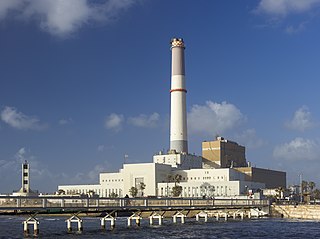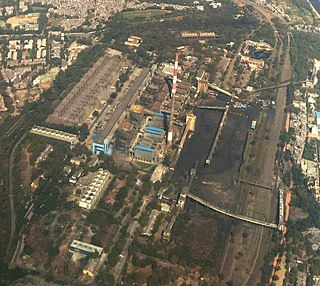
Drax power station is a large biomass power station in Drax, North Yorkshire, England. It has a 2.6 GW capacity for biomass and had a 1.29 GW capacity for coal that was retired in 2021. Its name comes from the nearby village of Drax. It is situated on the River Ouse between Selby and Goole. Its generating capacity of 3,906 megawatts (MW), which includes the shut down coal units, is the highest of any power station in the United Kingdom, providing about 6% of the United Kingdom's electricity supply.

Bankside Power Station is a decommissioned electricity generating station located on the south bank of the River Thames, in the Bankside area of the Borough of Southwark, London. It generated electricity from 1891 to 1981. It was also used as a training base for electrical and mechanical student apprenticeships from all over the country. Since 2000 the building has housed the Tate Modern art museum and gallery.

Flue-gas desulfurization (FGD) is a set of technologies used to remove sulfur dioxide from exhaust flue gases of fossil-fuel power plants, and from the emissions of other sulfur oxide emitting processes such as waste incineration, petroleum refineries, cement and lime kilns.

Israel Electric Corporation is the largest supplier of electrical power in Israel and the Palestinian territories. The IEC builds, maintains, and operates power generation stations, sub-stations, as well as transmission and distribution networks in Israel.

The Ferrybridge power stations were a series of three coal-fired power stations on the River Aire near Ferrybridge in West Yorkshire, England, in operation from 1927 to 2016 on a site next to the junction of the M62 and A1(M) motorways.

Reading Power Station is a natural gas fueled thermal power station supplying electrical power to the Tel Aviv District in central Israel. It is in the northwestern part of the city at the mouth of the Yarkon River.

The W. H. Sammis Power Plant was a 2.23-gigawatt coal power plant in Stratton, Jefferson County, Ohio. The plant was operated by Energy Harbor. It began operations in 1960.

Orot Rabin is a power station located on the Mediterranean coast in Hadera, Israel which is owned and operated by the Israel Electric Corporation (IEC). As of 2022 it is Israel’s largest power station and contains six thermal generation units capable of producing a total of 2.59GW of electricity using coal as the primary fuel. In addition, under construction at the site are two single-shaft natural gas-powered combined-cycle units capable of generating 630 MW each. The older, unmodernised four of its total six coal-fuelled units will be closed by mid-2022 in order to eliminate this major source of air pollution in the country.

Vasilikos Power Station is the newest power plant of Electricity Authority of Cyprus. Located between Larnaca and Limassol and with an installed capacity of 640 MW, it was still under development prior to the Evangelos Florakis Naval Base explosion of 11 July 2011.

The Eshkol Power Station is a power station supplying electrical power to the Shephelah region in Israel. It is located in north industrial zone of Ashdod near the mouth of the Lakhish River, close to the port of Ashdod and the Ashdod Oil Refineries which provided the plant with fuel oil prior to its conversion to use natural gas. The power station is also close to the sea since its cooling system uses sea water.

The Lingan Generating Station is a 620 MW Canadian coal-fired electrical generating station located in the community of Lingan in Nova Scotia's Cape Breton Regional Municipality. Lingan is operated by Nova Scotia Power Inc. and is their largest generating station.

The A. B. Brown Generating Station is a four-unit, 700 megawatt (MW) power plant, located on the northern bank of Ohio River, 8 miles (10 km) east of Mount Vernon, Indiana and 5 miles (8 km) southwest of Evansville, Indiana just west of the Posey-Vanderburgh County Line. Each of the two coal-fired units has a name-plate capacity of 265.2 MW. Bituminous coal is used as a primary fuel type, which can be substituted for natural gas. There are also two gas turbine units, 88.2 MW of nameplate capacity each. The facility is owned by Centerpoint Energy. Vectren announced a plan to retire the plant in 2023 and replace it with a natural gas power plant; however, this plan needs to be approved by the Indiana Utility Regulatory Commission.

John E. Amos Power Plant is a three-unit coal-fired power plant owned and operated by Appalachian Power, a subsidiary of American Electric Power (AEP). With a nameplate rating of 2,933 MW, it is the largest generating plant in the AEP system. It was named after John E. Amos, a prominent state senator, Democratic National Committee member from West Virginia, and member of the AEP board of directors.

The West Burton power stations are a pair of power stations on the River Trent, near Gainsborough, Lincolnshire, England. West Burton A was a coal-fired power station, one of the Hinton Heavies which was commissioned in 1966 and operated until 2023. West Burton B on the other hand, is a combined cycle gas turbine power station, commissioned in 2013. West Burton A is owned by EDF Energy, while West Burton B is owned and operated by Totalenergies.

The Tilbury power stations were two thermal power stations on the north bank of the River Thames at Tilbury in Essex. The 360 MW dual coal- and oil-fired Tilbury A Power Station operated from 1956 until 1981 when it was mothballed, prior to demolition in 1999. The 1,428 MW Tilbury B Power Station operated between 1968 and 2013 and was fueled by coal, as well as co-firing with oil and, from 2011, biomass. Tilbury B was demolished in 2016–19. Since 2013 three other power stations have been proposed or constructed in Tilbury.

Centralia Big Hanaford power plant is a coal-fired power plant supplemented with natural-gas-fired units. It is located east of Centralia, Washington, United States in Lewis County. It is the only commercial coal-fired power plant in the State of Washington.

Badarpur Thermal Power Station was a Power Station located at Badarpur area in NCT Delhi. The power plant was one of the coal based power plants of NTPC. The National Power Training Institute (NPTI) for North India Region under Ministry of Power, Government of India was established at Badarpur in 1974, within the Badarpur Thermal power plant (BTPS) complex. The power plant permanently shut down on 15 October 2018.
The Dalhousie Generating Station was a 315 MW coal and oil-fired electrical generating station that operated from 1969-2012 in the community of Dalhousie in Restigouche County, New Brunswick.

Conesville Power Plant was a 2-gigwatt, coal power plant located east of Conesville, Ohio in Coshocton County, Ohio. Its units were co-owned at the time of its closing by American Electric Power (AEP) and AES Ohio Generation. All plant operations were handled by AEP. Conesville began operations in 1957 and ceased generation in April 2020.
Blackburn power stations are a series of electricity generating stations that have provided electric power to the town of Blackburn and the wider area from 1895 to the present. The first station in Jubilee Street, Blackburn began operating in 1895. A new larger station known as Blackburn East or Whitebirk power station was commissioned in 1921 and was rebuilt in stages over the period 1942 to 1955. Whitebirk station closed in 1976. The 60 MW Blackburn Mill Combined Cycle Gas Turbine (CCGT) power station has generated electricity since 2002. The Blackburn energy from waste (EfW) plant is currently (2020) being planned.



















